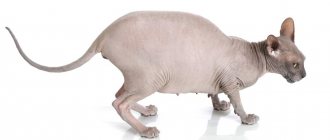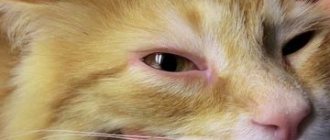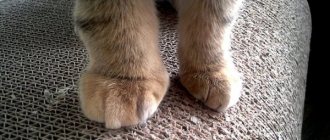The first hours after surgery
If the cat was castrated in a clinic, then the pet must spend the first hour there. This is the most difficult moment: the animal comes out of anesthesia, and the veterinarian must make sure that everything happens according to plan - no complications are observed.
The second and third hours spent at home are still quite difficult. The cat has general weakness and dizziness. He is most likely thirsty, but also feels nauseous. And what is most important to a pet now is the love and attention of its owner.
We recommend reading the article about the behavior of a cat after castration.
Key points to pay attention to at this time:
- Drying of the ocular conjunctiva. During the operation, the pet's eyes remain open. The doctor regularly moistens them using special drops. At home, this procedure should be done by the owner, placing tetracycline ointment or a special “Diamond Eyes” solution under the cat’s eyelids.
- Decrease in temperature. Most likely, at first it will remain at 37 °C, which is two degrees below normal. Your pet may experience mild tremors from time to time. Therefore, it is better to place it in a warm place and cover it with a blanket. As a last resort, you can use an electric heating pad in a case or a hot water bottle wrapped in a towel.
- Impaired coordination of movements. Due to high muscle weakness, when trying to stand up or walk, the cat may stagger from side to side. It is better to try to persuade him to lie down with gentle persuasion. This will pass in a couple of hours, now the main thing is to make sure that your pet does not fall, especially from a height.
- Refusal to eat. The cat is unlikely to develop an appetite in the first hours. Abstinence now is only good for him. Otherwise, vomiting may begin.
- Painful sensations. It is advisable to ask your doctor in advance what painkillers you can use. Signs that a pet is suffering may include dilated pupils, pursed paws, and aggression when attempting contact.
Use of additional veterinary drugs
If cats have been sterilized, post-operative care periodically involves the use of additional veterinary medications. They help the animal recover faster and gain strength. The decision to prescribe certain medications is made by a veterinarian based on an analysis of the animal’s condition.
Vitamins are prescribed by a veterinarian to ensure that weakened animals receive all the necessary nutrients. Hyperimmune serum helps prevent infection, and hemostatic medications are used to normalize blood clotting.
These drugs may not be used for animals that have strong immunity and good health. However, weakened, sick or injured animals cannot withstand the sterilization procedure without additional stimulants.
If the owner knows how to care for a cat after sterilization surgery and follows all the veterinarian’s recommendations during the postoperative period, then he will give the pet a chance to survive the surgery as comfortably as possible. With proper care, the pet will return to its normal life and usual diet, and will delight the owner with its lively and playful behavior.
Castration of cats means the cessation of reproductive function as a result of removal of the gonads through surgery. After such an operation, profound biochemical changes occur in the animal’s body, mainly the nature of metabolism changes. Cats, as a rule, become calmer, more balanced and, most importantly, stop marking corners in a house or apartment.
Treatment of the surgical wound
During the first two weeks, the surgical area must be inspected regularly and checked to avoid bleeding or infection of the wound.
During the first week, to speed up the healing of the stitches, they should be treated with hydrogen peroxide twice a day and smeared with a solution of brilliant green. Later you can use iodine. In case of the slightest redness, you can lubricate the surgical area with Levomekol.
To prevent the cat from injuring the operating area, it is better to put a special collar on him for the first days. Otherwise, as a result of licking, the seams may come apart.
It is better to do the operation in winter or autumn. During this period, the likelihood of wound infection is less. During the summer, your veterinarian will usually prescribe a course of antibiotics for at least five days.
Toilet
As soon as the cat begins to stand up, it is necessary to place a litter tray with low sides near the bed. It is better to add a filler (silica gel is better, it does not create dust and dirt) that is light in color, so that you can immediately see if there is bleeding or pus.
If this is necessary, then on the first day you can use special diapers for cats.
If the cat avoids the toilet in the first days, this is understandable. Firstly, he had hardly eaten or drunk anything yet. Secondly, he experiences pain and discomfort and delays this moment. As a last resort, you can give your pet a little Vaseline oil.
It’s also okay if the cat goes to the toilet in small portions. This is normal for the first days. Within a month everything should be back to normal. And, most importantly, the urine will no longer have a pungent odor.
Limitation of mobility.
Healing of wounds after castration takes from 7 to 14 days, so it is recommended that the cat lead a quiet lifestyle during this time - this will allow the stitches to heal better.
Even if the cat feels well, runs and plays with its usual activity, you should not let it outside (at least 7 days). This will prevent excessive physical activity, which could interfere with healing, and will also prevent dirt and dust from entering the surgical wounds.
Cat nutrition after castration
In the first hours and days, due to the effects of anesthesia and pain, the cat will not have time to eat. The main thing is not to force your pet to eat, this will only irritate him once again. Clean and fresh water should always be nearby. As soon as the nausea passes, the cat will quench its thirst.
Soon your appetite will return and, most likely, it will be increased. Overeating should not be indulged. Changes in hormonal levels can easily lead to obesity and related diseases. But if the cat refuses to eat two days after the procedure, this is an alarming factor. You need to contact a veterinarian.
As for the diet, it is better to gradually switch to special food for neutered cats or preventive food to prevent urolithiasis. If your pet is on a natural diet, remove fish and any food excessively enriched with calcium, phosphorus, and magnesium from the daily diet.
Dry food causes acidification of urine, which is also a prevention of urolithiasis, so this diet should be preferred. But drinking should always be plentiful. Read more in the article on what to feed a neutered cat.
Wearing a collar and blanket
When the pet has completely recovered from the anesthesia, he will try to remove the protective collar. The owner must prevent this, since pity for the animal will ultimately lead to disastrous consequences - the cat will begin to lick the stitches, inflammation will appear, and in addition to wearing a collar for two to three weeks, the pet will be additionally prescribed a whole course of potent antibiotics that put a strain on the internal organs.
The cat will get used to the blanket in two to three days and will be able to eat and drink water normally with a protective collar around its neck. If the owner cannot understand why the cat does not eat after sterilization, then he needs to pay attention to the position of the bowl. It should stand at a certain height from the floor and have a slightly smaller size than the diameter of the collar on the pet’s neck. These conditions are necessary so that the cat can easily reach the food bowl and gain access to food.
Your veterinarian may recommend a bandage for your cat after sterilization, which will reduce stress and allow the sutures to heal quickly. A correctly used post-operative cat bandage will help the animal experience less pain when moving. It is indicated not only after the sterilization procedure, but also after any abdominal surgery in animals.
Mr. Cat recommends: possible complications
Typically, recovery after castration proceeds calmly, without deterioration of the condition. But you need to be aware of what cases may occur and be prepared for them.
Complications can be early or late.
Their first signs may appear on the operating table. They are expressed in bleeding and prolapse of the omentum or testes - the organs closest to the operating area. Good recovery care will help resolve this problem quickly.
Late complications are most often associated with wound infection. There may be several reasons - unsterile instruments, poorly treated surgical area, violations in postoperative care.
Symptoms that should cause concern to the owner:
- Increase in body temperature by more than two degrees above normal.
- Change in gait. They often say that the cat is experiencing pain and discomfort.
- Refusal to eat, apathy for several days.
- Increased thirst or refusal of water.
- Nasal discharge, sneezing.
- Pain when palpating the operating area.
- The cat has difficulty going to the toilet.
- Discharge from the wound in the form of pus and ichor.
- The pet's heavy breathing, shortness of breath, arrhythmia and tachycardia.
It is necessary to immediately contact the surgeon who operated on the cat and tell him about the alarming symptoms.
The most common complication, but nevertheless rare, is inflammation of the scrotum and surrounding tissues. If your pet has cryptorchidism, then this pathology is much more difficult for them to tolerate. Since the castration procedure itself was more difficult, because with this phenomenon the testes do not descend into the scrotum, and the operation becomes essentially cavitary. Usually the recovery period in this case is longer.
How to wash a cat if there is no special shampoo?
Veterinarians strongly do not recommend bathing cats with ordinary human shampoo. The pH of an animal is different from that of a human; on average, it is higher. Human cosmetics can cause skin diseases in a cat or damage its fur.
Fortunately, pet stores and veterinary pharmacies have a variety of cat bath products.
What are they? According to the form of release, shampoos for cats are:
- dry
- liquid
- in the form of sprays
Dry shampoo is a real salvation for cat owners who do not like to bathe. The product has the form of powder, which is applied to the animal’s fur coat and after a while is removed from it with a comb. It is also suitable for long-haired cats, which take a long time to dry after regular bathing and risk catching a cold. The disadvantages of dry shampoo are that it cannot cope with heavy dirt and is not very suitable for cats with dark hair.
Shampoo-powder for cats.
The choice of spray shampoos is not yet very wide; they work on the same principle as dry ones. In addition, sprays protect the animal's fur from static electricity.
Shampoo in spray for cats.
Liquid shampoos are still the most popular. They clean the cat's fur well from dirt, make it easier to comb, and help cope with many problems. Liquid cat shampoos are:
- for cats of different breeds with different hair lengths or hairless
- for cats with oily or dry skin
- tint, emphasizing or slightly changing the natural color of the animal
- anti-parasitic against fleas
- from tangles and to make combing easier
- antifungal
- preventive, for regular hair and skin care
Liquid shampoos for cats.
Of course, when you get a cat, it is better to immediately buy shampoo for him. But if it happens that your pet gets dirty, and there is no special product to wash it, you can use regular human shampoo once, preferably baby shampoo:
- fragrance-free
- no dyes
- hypoallergenic
It is better not to use shampoo with conditioner.
You can also make a weak solution of laundry soap and rinse it off the wool very thoroughly.
Regular shampoo means human shampoo.
It is not suitable for cats: humans and cats have different acid-base balance of the skin - our skin pH = 5.5, a cat’s pH = 7.5. Our shampoo contains a large amount of alkali.
We suggest you read: Can cats be given Paracetamol?
This shampoo is too aggressive for an animal. “Human” shampoo will remove the protective layer from the cat’s skin and make the animal susceptible to infections and colds, and will also cause the pet to itch continuously.
Important rules for owners
Additional recommendations that the owner of an operated cat must follow:
- If your pet used to walk outside, then during the week he is strictly prohibited from walking. So are active games. The main thing now is to preserve the postoperative sutures and prevent them from coming apart and becoming infected.
- Be sure to use an Elizabethan collar to limit licking of the operating area. You will have to wear it for at least a week. If your pet repeatedly tries to remove it, you should consult a veterinarian; you may have to use sedatives. When using them, the cat will almost always sleep.
- Some experts advise that in the first days, remove the litter from the toilet altogether and put shredded toilet paper in it (it is strictly forbidden to use newspapers for these purposes). This measure can prevent infection of the surgical suture and the canal itself.
- You should not bathe your pet for one to two weeks after surgery.
- During the first two days, the cat may experience pain. If the period of suffering drags on, this is an alarming sign; a hematoma or inflammation may develop. It is necessary to urgently consult a veterinarian.
In agreement with the surgeon, the following painkillers can be used in the first two days:
- Ketofen - in tablets or injections. Dosage 1 mg or 0.2 ml per 1 kg of cat weight.
- Ainil is a solution for subcutaneous administration (0.2 ml per 1 kg of weight).
- Previcox is a generic tablet drug. One dose is prescribed per 3 kg of animal weight.
The effect of one tablet or injection is designed for 12 hours, that is, analgesics cannot be given more than twice a day.
If after two days the pain continues, you should consult a surgeon.
Preparing for swimming at home
The cat needs to be prepared for bathing - the main emphasis is on the animal’s fur and the choice of tools.
Remove unnecessary things
First you need to untangle all the tangles and remove matted hairs. This will help significantly facilitate and speed up the process, and the pet will experience less discomfort.
Some owners wash their cats directly in the bathroom, but this option is not always the best. It is better to place your pet in a small basin, which will cause less stress to the animal. The bottom of the basin should be covered with a thick towel.
Some people use a rubber mat, but most often cats are calmer on a fabric surface.
Water temperature 33-35 degrees
The water temperature should range between 33–38 °C. When using a shower, the water pressure should not be too strong, otherwise you can frighten the animal or cause it pain.
Is it possible to wash with shampoo for humans?
The minimum temperature in the bathing room is 22 °C.
Special shampoo for cats
It is recommended to purchase a special shampoo for washing cats. Before use, you should read the instructions for use of the product.
- Dry shampoo in powder form. They usually sprinkle it on the pet, and then carefully comb out all the dirt. Well suited for heavy contamination, it allows you to avoid trauma to the animal’s psyche, as usually happens when in contact with water.
- Spray. A good alternative to powder, however, not all animals like the specific sound of a spray bottle.
- Classical. A product adapted for cats in the form of a regular shampoo. It is considered the most universal option.
It is strictly forbidden to wet your cat's head while bathing! If water gets into your ears, it can cause inflammation!
Is it possible to wash with laundry soap?
Some owners ask: how to wash a cat with laundry soap? It is important to note that using laundry soap while bathing cats is strictly prohibited. Only special cleaning products are suitable for cats.
Is it possible to wash with shampoo for humans?
It is strongly not recommended to use ordinary hygiene products - soap, simple shampoos, etc. when bathing animals.
A high concentration of substances in their composition can have a detrimental effect on your pet’s skin, causing irritation and hair problems. Therefore, the answer to the question - is it possible to wash a cat with human shampoo - is no, it is not possible.











